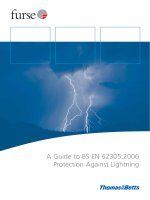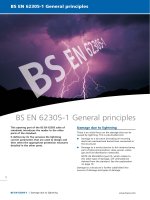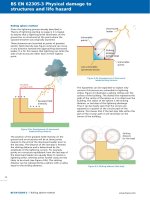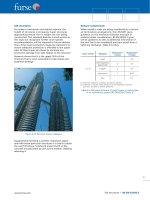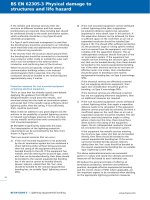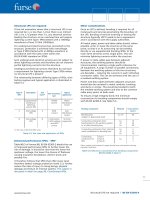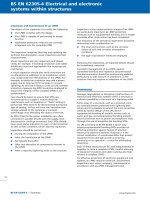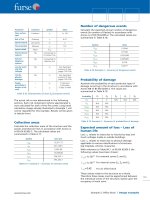Bsi bs en 00690 2013
Bạn đang xem bản rút gọn của tài liệu. Xem và tải ngay bản đầy đủ của tài liệu tại đây (1.46 MB, 36 trang )
BS EN 690:2013
BSI Standards Publication
Agricultural machinery —
Manure spreaders — Safety
BS EN 690:2013
BRITISH STANDARD
National foreword
This British Standard is the UK implementation of EN 690:2013. It
supersedes BS EN 690:1994+A1:2009 which is withdrawn.
BSI, as a member of CEN, is obliged to publish EN 690 as a British
Standard. However, attention is drawn to the fact that during the
development of this European Standard, the UK committee voted
against its approval as a European Standard. In the opinion of the
UK committee, clause 5.3.2 is not applicable to machinery currently
in use and it requires further review. It is subject to amendment by
CEN/TC 144/WG 3, together with other technical issues.
The UK participation in its preparation was entrusted to Technical
Committee AGE/32, Agricultural implements and trailers.
A list of organizations represented on this committee can be
obtained on request to its secretary.
This publication does not purport to include all the necessary
provisions of a contract. Users are responsible for its correct
application.
© The British Standards Institution 2014. Published by BSI Standards
Limited 2014
ISBN 978 0 580 77023 4
ICS 65.060.25
Compliance with a British Standard cannot confer immunity from
legal obligations.
This British Standard was published under the authority of the
Standards Policy and Strategy Committee on 31 May 2014.
Amendments
issued sinceissued
publication
Amendments/corrigenda
since publication
Date
Date
Text
affected
Text
affected
BS EN 690:2013
EN 690
EUROPEAN STANDARD
NORME EUROPÉENNE
EUROPÄISCHE NORM
October 2013
ICS 65.060.25
Supersedes EN 690:1994+A1:2009
English Version
Agricultural machinery - Manure spreaders - Safety
Matériel agricole - Epandeurs de fumier - Sécurité
Landmaschinen - Stalldungstreuer - Sicherheit
This European Standard was approved by CEN on 14 September 2013.
CEN members are bound to comply with the CEN/CENELEC Internal Regulations which stipulate the conditions for giving this European
Standard the status of a national standard without any alteration. Up-to-date lists and bibliographical references concerning such national
standards may be obtained on application to the CEN-CENELEC Management Centre or to any CEN member.
This European Standard exists in three official versions (English, French, German). A version in any other language made by translation
under the responsibility of a CEN member into its own language and notified to the CEN-CENELEC Management Centre has the same
status as the official versions.
CEN members are the national standards bodies of Austria, Belgium, Bulgaria, Croatia, Cyprus, Czech Republic, Denmark, Estonia,
Finland, Former Yugoslav Republic of Macedonia, France, Germany, Greece, Hungary, Iceland, Ireland, Italy, Latvia, Lithuania,
Luxembourg, Malta, Netherlands, Norway, Poland, Portugal, Romania, Slovakia, Slovenia, Spain, Sweden, Switzerland, Turkey and United
Kingdom.
EUROPEAN COMMITTEE FOR STANDARDIZATION
COMITÉ EUROPÉEN DE NORMALISATION
EUROPÄISCHES KOMITEE FÜR NORMUNG
CEN-CENELEC Management Centre: Avenue Marnix 17, B-1000 Brussels
© 2013 CEN
All rights of exploitation in any form and by any means reserved
worldwide for CEN national Members.
Ref. No. EN 690:2013: E
BS EN 690:2013
BS
EN 690:2013
EN
EN 690:2013
690:2013 (E)
(E)
Contents
Page
Foreword..............................................................................................................................................................3
Introduction .........................................................................................................................................................4
1
Scope ......................................................................................................................................................5
2
Normative references ............................................................................................................................5
3
Terms and definitions ...........................................................................................................................6
4
List of significant hazards ....................................................................................................................7
5
5.1
5.2
5.3
5.3.1
5.3.2
5.4
5.5
5.5.1
5.5.2
5.6
5.7
5.8
5.9
5.10
5.11
5.11.1
5.11.2
5.11.3
Safety requirements and/or protective measures ........................................................................... 12
General................................................................................................................................................. 12
Location of the manual controls ....................................................................................................... 13
Prevention of unintentional contact with the moving spreading device ...................................... 13
Self-propelled machines .................................................................................................................... 13
Mounted, semi-mounted and trailed machines ............................................................................... 13
Protection against projectiles ........................................................................................................... 13
Conveyor ............................................................................................................................................. 14
Guarding .............................................................................................................................................. 14
Adjustment of conveyor..................................................................................................................... 19
Means of access ................................................................................................................................. 20
Removal of the spreading device...................................................................................................... 20
Transmission shafts ........................................................................................................................... 20
Cleaning ............................................................................................................................................... 20
Special tools........................................................................................................................................ 20
Noise .................................................................................................................................................... 20
Noise reduction by design................................................................................................................. 20
Noise reduction by information......................................................................................................... 21
Noise emission values ....................................................................................................................... 21
6
Verification of safety requirements or protective measures.......................................................... 21
7
7.1
7.2
7.3
Information for use ............................................................................................................................. 22
Operator’s manual .............................................................................................................................. 22
Safety and instructional signs........................................................................................................... 24
Marking ................................................................................................................................................ 25
Annex A (informative) Illustrations of manure spreaders ............................................................................ 26
A.1
Examples of manure spreaders with rear spreading device dealt with in present EN 690......... 26
A.2
Examples of manure spreaders with lateral spreading – not dealt with in present EN 690 ....... 29
Annex ZA (informative) Relationship between this European Standard and the Essential
Requirements of EU Directive 2006/42/EC on machinery .............................................................. 30
Bibliography ..................................................................................................................................................... 31
2
BS EN 690:2013
BS
EN 690:2013
EN
690:2013 (E)
(E)
EN 690:2013
Foreword
This document (EN 690:2013) has been prepared by Technical Committee CEN/TC 144 “Tractors and
machinery for agriculture and forestry”, the secretariat of which is held by AFNOR.
This European Standard shall be given the status of a national standard, either by publication of an identical
text or by endorsement, at the latest by April 2014, and conflicting national standards shall be withdrawn at the
latest by April 2014.
Attention is drawn to the possibility that some of the elements of this document may be the subject of patent
rights. CEN [and/or CENELEC] shall not be held responsible for identifying any or all such patent rights.
This document supersedes EN 690:1994+A1:2009.
This document has been prepared under a mandate given to CEN by the European Commission and the
European Free Trade Association, and supports essential requirements of EU Directive(s).
For relationship with EU Directive(s), see informative Annex ZA, which is an integral part of this document.
The following main changes have been introduced during the revision of EN 690:1994+A1:2009:
Scope: inclusion of self-propelled, mounted, semi-mounted and trailed manure spreaders, except
spreaders with lateral spreading;
update of Normative References;
new requirements on prevention of unintentional contacts with moving spreading device;
new requirements regarding design for cleaning and maintenance operations;
new requirements regarding design and guarding of conveyor;
means of access;
noise.
According to the CEN-CENELEC Internal Regulations, the national standards organizations of the following
countries are bound to implement this European Standard: Austria, Belgium, Bulgaria, Croatia, Cyprus, Czech
Republic, Denmark, Estonia, Finland, Former Yugoslav Republic of Macedonia, France, Germany, Greece,
Hungary, Iceland, Ireland, Italy, Latvia, Lithuania, Luxembourg, Malta, Netherlands, Norway, Poland, Portugal,
Romania, Slovakia, Slovenia, Spain, Sweden, Switzerland, Turkey and the United Kingdom.
3
BS EN 690:2013
BS
EN 690:2013
EN
EN 690:2013
690:2013 (E)
(E)
Introduction
This document is a type-C standard as specified in EN ISO 12100.
The machinery concerned and the extent to which hazards, hazardous situations and hazardous events are
covered are indicated in the Scope of this document. These hazards are specific to manure spreaders.
Significant hazards that are common to all the agricultural machines (self-propelled, mounted, semi-mounted
and trailed) are dealt with in EN ISO 4254-1. When provisions of this type C standard are different from those
which are stated in type A or B standards, the provisions of this type C standard take precedence over the
provisions of the other standards, for machines that have been designed and built according to the provisions
of this type C standard.
4
BS EN 690:2013
BS
EN 690:2013
EN
690:2013 (E)
(E)
EN 690:2013
1
Scope
This European Standard, to be used together with EN ISO 4254-1, specifies the safety requirements and their
verification for the design and construction of self-propelled, mounted, semi-mounted and trailed manure
spreaders, provided with vertical or horizontal axes rotors rear spreader device or with vertical axes disc rear
spreader device. In addition, it specifies the type of information on safe working practices to be provided by
the manufacturer.
When requirements of this document are different from those which are stated in EN ISO 4254-1, the
requirements of this document take precedence over the requirements of EN ISO 4254-1 for machines that
have been designed and built according the provisions of this document.
This European Standard, taken together with EN ISO 4254-1, deals with all the significant hazards, hazardous
situations and events relevant to manure spreaders, when they are used as intended and under the conditions
of misuse which are reasonably foreseeable by the manufacturer (see Table 1), excepting the hazards arising
from:
vibrations of self-propelled machinery;
travelling function of self-propelled machinery;
overturning in regard to the protection of the operator at the driving station of a self-propelled machine;
hazards related to conveying devices other than those defined in 3.3.1 and 3.3.2, for example load
push/push-off device.
NOTE 1
Regarding roll-over protection for self-propelled agricultural machinery, see EN ISO 16231-1.
NOTE 2
This European Standard is neither applicable to environmental hazards nor to road safety. Environmental
aspects are dealt with in EN 13080.
This European Standard does not apply to manure spreaders with laterally mounted spreading device as
defined in 3.6.
This European Standard is not applicable to manure spreaders which are manufactured before the date of
publication of this document by CEN.
2
Normative references
The following documents, in whole or in part, are normatively referenced in this document and are
indispensable for its application. For dated references, only the edition cited applies. For undated references,
the latest edition of the referenced document (including any amendments) applies.
EN 15811, Agricultural machinery — Guards for moving parts of power transmission — Guard opening with
tool (ISO/TS 28923)
EN ISO 4254-1:2009, Agricultural machinery — Safety — Part 1: General requirements (ISO 4254-1:2008)
EN ISO 5353:1998, Earth-moving machinery, and tractors and machinery for agriculture and forestry — Seat
index point (ISO 5353:1995)
EN ISO 11688-1, Acoustics — Recommended practice for the design of low-noise machinery and equipment
– Part 1: Planning (ISO/TR 11688-1)
EN ISO 12100:2010, Safety of machinery — General principles for design — Risk assessment and risk
reduction (ISO 12100:2010)
5
BS EN 690:2013
BS
EN 690:2013
EN
EN 690:2013
690:2013 (E)
(E)
EN ISO 13857:2008, Safety of machinery — Safety distances to prevent hazard zones being reached by
upper and lower limbs (ISO 13857:2008)
EN ISO 14982, Agricultural and forestry machinery — Electromagnetic compatibility — Test methods and
acceptance criteria (ISO 14982)
ISO 3600, Tractors, machinery for agriculture and forestry, powered lawn and garden equipment —
Operator's manuals — Content and presentation
3
Terms and definitions
For the purposes of this document, the terms and definitions given in EN ISO 12100:2010 and the following
apply.
3.1
manure spreader
machine for transporting and spreading manure and/or other mainly non-liquid organic products or soil
improvers (e.g. lime) on the field
Note 1 to entry:
See examples in Annex A, Figures A.1, A.2 and A.3.
3.2
load body
volume consisting of a platform with three walls and a spreading device at the rear able to contain the product
for its transport and spreading
3.3
conveyor device
device able to convey/move/carry the material in the load body to the spreading device, that are of three
types: scraper floor, conveyor belt or load push/push-off device
3.3.1
scraper floor
conveyor device made by two or more dragging chains and by a number of slats
3.3.2
conveyor belt(s)
conveyor device made by belt(s)
3.3.3
load push
push-off device
conveyor device formed by a moveable wall for pushing the material in the load body to the spreading device
3.4
rear spreading device
device made by rotary elements (e.g. rotors or discs) intended for spreading the product contained inside the
load body
Note 1 to entry:
See examples in Annex A, Figure A.4 and A.5.
3.4.1
rear spreading device with rotor(s)
device formed by rotor(s) with vertical or horizontal rotation axe
6
BS EN 690:2013
BS
EN 690:2013
EN
690:2013 (E)
(E)
EN 690:2013
3.4.2
rear spreading device with discs
device formed by two or more discs with vertical rotation axes
3.5
working tools of the spreading device
components (as teeth, saw-blades, etc.) fixed on spreading device for catching the product inside the load
body, and spreading it
3.6
manure spreader with lateral spreading
manure spreader (3.1) that spreads laterally
Note 1 to entry:
See examples in Annex A, Figure A.6.
3.7
entry point
point at which the conveyor chains enter the (chain) sprocket(s)
3.8
reverse movement of conveyor
movement of the conveyor opposite to the working direction for removal of disorders, such as blockages
4
List of significant hazards
Table 1 gives the significant hazard(s), the significant hazardous situation(s) and hazardous event(s) covered
by this document that have been identified by risk assessment as being significant for this type of machine,
and which require specific action by the designer or manufacturer to eliminate or reduce the risk.
Attention is drawn to the necessity to verify that the safety requirements specified in this document apply to
each significant hazard presented by a given machine and to validate that the risk assessment is complete.
Table 1 — List of significant hazards associated with manure spreaders
No.
a
Hazard, hazardous situation
or hazardous event
A.1
Mechanical hazards
A.1.1
Crushing hazard
Origin
Clause/subclause of Clause/subclause of
EN ISO 4254-1:2009 this document
Controls
4.4.3; 5.1.3.2; 5.1.8;
6.1
5.2
Access means
4.5.1.1.2; 4.5.1.2.5;
4.5.2.3; 4.6
—
4.7
5.3; 5.5.1; 5.9; 7.1
Service points, service and
maintenance operations
4.8; 4.14.1; 4.14.3;
4.14.5; 4.14.6
5.5.2; 5.9; 7.1
Roll-over
5.1.2.3
—
Working elements
/conveyor/spreading devices
Shearing and pinching
points at the operator's work 5.1.4
station
—
Moving the machine
5.2
—
Lack of stability
6.2
7.1
Mounting of
machines/coupling area
6.2.2; 6.2.3; 6.3
—
7
BS EN 690:2013
BS
EN 690:2013
EN
EN 690:2013
690:2013 (E)
(E)
Table 1 (continued)
No.
a
A.1.2
Hazard, hazardous situation
or hazardous event
Origin
Shearing hazard
Controls
4.4.3; 5.1.3.1; 5.1.3.3;
5.2
5.1.8; 6.1
Access means
4.5.1.1.2; 4.5.1.2.5;
4.5.2.3; 4.6
—
4.7
5.3; 5.5.1; 5.9; 7.1
4.8; 4.14.1; 4.14.3;
4.14.5; 4.14.6
5.5.2; 5.9; 7.1
Clause/subclause of Clause/subclause of
EN ISO 4254-1:2009 this document
Power transmission parts
Working elements
/conveyor/spreading devices
Service points, service and
maintenance operations
A.1.3
Cutting or severing hazard
Shearing and pinching
points at the operator's work 5.1.4
station
—
Moving the machine
5.2
—
Lack of stability
6.2
7.1
Mounting of machines
6.2.2; 6.2.3; 6.3
—
4.7
5.2;; 5.3; 5.5.1; 5.5.2;
5.9; 7.1
Working elements
/conveyor/spreading devices
A.1.4
Entanglement hazard
Power transmission parts
Driving gear of spreading
device
Working elements
5.6; 5.8
6.4
5.7
4.7
5.2; 5.3; 5.5.1; 5.5.2;
5.9; 7.1
/conveyor/spreading devices
Starting/stopping the engine
5.1.8
with engaged drive(s)
A.1.5
Drawing-in or trapping hazard
Power transmission parts
Driving gear
5.6; 5.8
6.4
Working Elements/conveyor/ 4.7
spreading devices
5.1.8
Starting/stopping the engine
with engaged drive(s)
A.1.6
Impact hazard
A.1.7
Stabbing or puncture hazard
Friction or abrasion hazard
A.1.9
High-pressure fluid injection or
ejection hazard
A.2
Electrical hazards
A.2.1
Contact of persons with live
parts (direct contact)
8
5.7
5.2; 5.3; 5.5.1; 5.5.2;
5.9; 7.1
7.1; 7.2
Access means
4.5.1.2.5
—
Steering system
5.1.3.1
—
Spreading devices
Projectiles
A.1.8
7.1; 7.2
4.7
5.9
5.4
Controls
4.4.3; 5.1.3.2
Electrical equipment,
4.9.1
—
Access means
4.5.1.1.2
—
Hydraulic components and
fittings (e.g. rupture)
4.10; 6.5
—
4.9; 5.3, 6.5
—
Electrical equipment
BS EN 690:2013
BS
EN 690:2013
EN
690:2013 (E)
(E)
EN 690:2013
Table 1 (continued)
No.
a
A.2.2
A.2.4
A.3
Hazard, hazardous situation
or hazardous event
Contact of persons with parts
which have become live under
faulty conditions (indirect
contact)
Clause/subclause of Clause/subclause of
EN ISO 4254-1:2009 this document
Electrical equipment
4.9.1
Thermal radiation or other
Electrical equipment
phenomena such as the
projection of molten particles
and chemical effects from short
circuits, overloads, etc.
4.9.2; 5.3.1
—
—
Hydraulic system, operating
fluids (e.g. fuel, hydraulic oil, 4.12
engine coolant)
—
Cab material
5.1.6
—
5.5
—
4.2
5.11
Operating fluids (fuel tank,
hydraulic systems, engine
cooling system)
4.10; 5.4
—
Cab material
5.1.6
—
Battery
5.3.1
—
Exhaust system
5.6
—
Cab material
5.1.6
—
Hot surfaces
Hazards generated by noise
Hearing loss (deafness), other
physiological disorders (e.g.
loss of balance, loss of
awareness), accidents due to
speech communication and
acoustic warning signals
Noise
A.5
Hazards generated by materials and substances
A.5.1
Hazards from contact with or
inhalation of harmful fluids,
gases, mists, fumes and dusts
A.5.2
Fire or explosion hazard
A.6
Hazards generated by neglecting ergonomic principles in machinery design
A.6.1
Unhealthy postures or
excessive effort
A.6.2
—
Thermal hazards
Burns, scalds and other injuries
by possible contact between
persons and objects or
materials with an extreme high
or low temperature, by flames
or explosions and also by the
radiation of heat sources
A.4
Origin
Non- or inadequate
consideration of hand–arm or
foot–leg anatomy
Controls
4.4
—
Access means
4.5; 4.6
5.6
Service and maintenance
operations
4.14.2; 4.14.4
5.5.2; 5.9; 7.1
operator's station
5.1.1; 5.1.2.1; 5.1.3;
—
Controls
4.4
5.2
Access means
4.5; 4.6
5.6
Operator's station
5.1
—
8.1.3
7.1
5.1.7.3
—
A.6.3
Neglected use of personal
protective equipment
Operator's manual
A.6.4
Inadequate local lighting
Visibility
A.6.5
Mental overload and under
load, stress
Controls
A.6.6
Human error, human behaviour Controls
4.4
4.4
—
8.1
7.1
Location and design of signs 8.2
7.2
Operator's manual
9
BS EN 690:2013
BS
EN 690:2013
EN
EN 690:2013
690:2013 (E)
(E)
Table 1 (continued)
No.
a
Hazard, hazardous situation
or hazardous event
Origin
Clause/subclause of Clause/subclause of
EN ISO 4254-1:2009 this document
A.6.7
Design, location or identification Design, location and
of manual controls
identification of controls
4.4; 5.1.3; 6.1, 8.1.3.c) —
A.7
Combination of hazards
Individual assemblies
4.13
5.7
Operator's manual
8.1
7.1
—
A.8
Unexpected start-up, unexpected overrun/overspeed
A.8.1
Failure/disorder of the control
system
Service and maintenance
4.8
Electrical equipment
4.9
Connections
6.5
A.8.2
Restoration of energy supply
after an interruption
Control
A.8.3
External influences on electrical Cables
equipment
Electrical/Electronic
components
4.4; 6.1
—
—
4.9.1
—
5.1.4
6.2.1.1; 6.2.1.2
7.1
A.8.4
Other external influences
(gravity, wind, etc.)
Stability
A.8.6
Errors made by the operator
(due to mismatch of machinery
with human characteristics and
abilities, see 8.6)
Design and location of
controls
4.4; 6.1.2
—
Access means
4.5 , 4.6
—
Operator's work station
5.1
—
Moving the machine
5.2
—
Service and maintenance
systems
4.14
7.1
Mounting system of
machines
6.2; 6.3
7.1
Missing or insufficient
instructions in the operator's 8.1.3
manual
A.9
Impossibility of stopping the
machine in the best possible
conditions
Control
A.11
Failure of energy supply
A.12
Failure of the control circuit
A.13
Errors of fitting
A.14
A.15
Break-up (of parts) during
operation
Falling or ejected objects or
fluids
4.4; 6.1
—
Supports
4.8
7.1
Electrical equipment
4.9
Connections
6.5
Electrical equipment
4.9
—
Mounting of machines
6.2; 6.3
7.1
—
Missing or insufficient
instructions in the operator's 8.1.3
manual
7.1
Guards and barriers
(strength)
4.7
—
Supports
4.8
—
Hydraulic components
4.10
Pneumatic components
4.11
Supports
4.8
—
Hydraulic components
4.10
—
Projectiles
10
7.1
—
5.4
BS EN 690:2013
BS
EN 690:2013
EN
690:2013 (E)
(E)
EN 690:2013
Table 1 (continued)
No.
a
A.16
A.17
Hazard, hazardous situation
or hazardous event
Origin
Clause/subclause of Clause/subclause of
EN ISO 4254-1:2009 this document
Loss of stability/Overturning
of the machine
Stability
6.2
7.1
Roll over
5.1.2.3
—
Slip, trap and fall of persons
(related to machinery)
Access means
4.5; 4.6
5.6
Additional hazards, hazardous situations or hazardous events linked with mobility
A.18
Related to the travelling function
A.18.1
Movement when starting the
engine
A.18.2
Movement without a driver at
the driving position
Propulsion of the machine
5.1.2.3
—
Starting/stopping the engine 5.1.8
—
Propulsion of machine
—
5.1.2.3
Starting/stopping the engine 5.1.8
A.18.4
Insufficient ability of machinery
to be slowed down, stopped
and immobilised
Propulsion of the machine
A.19
Linked to the work position
A.19.1
Fall of persons during access to Access means
(or at/from) the work position
—
5.1.3.2
—
4.5; 4.6
5.6
5.4.1; 5.6
—
5.1.6
—
A.19.2
Exhaust gases/lack of oxygen
at the work position
Cabin
A.19.3
Fire (flammability of the cab,
lack of extinguishing means)
Cab material
A.19.4
Mechanical hazards at the
working position:
Shearing /pinching points
4.4.3; 4.5.1.2.5; 5.1.4
5.5.1
Wheels
4.5.1.2
5.5.2
PTO drive shaft(s)
4.6.4
5.6
Supports
4.8
—
Roll over
5.1.2.3
—
a) contact with wheels
b) rollover
c) break-up of parts rotating at
high speed
Projectiles
A.19.5
Insufficient visibility from the
work positions
Visibility
A.19.6
Inadequate lighting
Provisions for installing of
working lights
A.19.7
Inadequate seating
Operator's seat
A.19.8
Noise at work position
Working of the machine
A.19.9
Insufficient means of
evacuation/emergency exit
Emergency exits
A.20
Due to the control system
A.20.1
Inadequate location of manual
controls
Controls
A.20.2
Inadequate design of manual
controls and their mode of
operation
Controls
5.4
5.1.7
—
5.1.7
—
5.1.2
—
4.2
5.11
5.1.5
—
4.4; 4.8.1.2; 5.1.2.1;
6.1.1; 6.1.2
—
4.4; 5.1.3; 5.1.8
—
11
BS EN 690:2013
BS
EN 690:2013
EN
EN 690:2013
690:2013 (E)
(E)
Table 1 (continued)
No.
a
A.21
Hazard, hazardous situation
or hazardous event
Origin
From handling the machine
(lack of stability)
Lack of stability of the
machine when in operation
6.2
Roll-over
5.1.2.3
A.22
Due to the power source and to the transmission of power
A.22.1
Hazards from the engine and
the batteries
Clause/subclause of Clause/subclause of
EN ISO 4254-1:2009 this document
5.7; 7.1
Starting/stopping the engine 5.1.8
—
Battery
5.3
—
6.4 , 6.5
—
A.24.2
Hazards from transmission of
power between machines
Power transmission
A.24.3
Hazards from coupling and
towing
Mounting of machines
Braking connection
6.2.2; 6.2.3; 6.3
Missing or insufficient
instructions in the operator's 8.1.3
manual
A.23
From/to third persons
A.23.1
Unauthorised start-up and use
Starting/stopping the engine
Engagement of power
transmission
A.23.2
A.24
a
5
Lack or inadequacy of visual or
acoustic warning means
Visibility
Insufficient instructions for
the driver/operator
Operator's manual
Warning
5.1.8
—
7.1
7.1
7.1
5.3.1
5.1.7
5.3.2; 7.1
8.1
7.1
With reference to EN ISO 4254-1:2009, Table A.1.
Safety requirements and/or protective measures
5.1
5.1.1
General
Machinery shall comply with the safety requirements and/or protective measures of this clause.
In addition, the machine shall be designed according to the principles of EN ISO 12100 for relevant but not
significant hazards which are not dealt with by this document.
5.1.2 Unless otherwise specified in this document, the machine shall comply with the requirements of
EN ISO 4254-1, EN 15811 and with requirements of appropriate Tables 1, 3, 4 and 6 of EN ISO 13857:2008.
5.1.3
Openings in fixed guards and movable guards when closed shall comply with Table 4 of
EN ISO 13857:2008.
Fixed guards that require routine removal for maintenance or adjustment shall be retained by fixings that are
retained in the guard or machine.
5.1.4
Machinery shall comply with EN ISO 14982 regarding electromagnetic compatibility.
5.1.5 The compliance with the safety requirements and/or measures shall be verified in accordance with
Clause 6.
12
BS EN 690:2013
BS
EN 690:2013
EN
690:2013 (E)
(E)
EN 690:2013
5.2
Location of the manual controls
Manual controls, in particular those for speed adjustment of conveyor device, shall be located at a minimum
distance of 850 mm from every unguarded movable element of the spreading device.
5.3
5.3.1
Prevention of unintentional contact with the moving spreading device
Self-propelled machines
For prevention of unintentional contact with the moving spreading device, self-propelled machines shall have
a system that prevents engagement of the spreading device if the operator is not in the operator’s work station
and that automatically disengages the spreading device when the operator leaves the operator’s work station.
The maximum delay time for triggering the disengagement shall be 3 s.
Spreading device starting shall require intentional reactivation by means other than the automatic spreading
device disengagement control after stopping.
5.3.2
Mounted, semi-mounted and trailed machines
Technical measures shall be taken, at least, by means of an audible signal or flashing light located near the
spreading device, to warn when the spreading device is running and the machine is not travelling.
Defect of signal shall be avoided, e.g. by associating its power to that of the spreading device.
Delay between stop of machine travel and signal emission shall be 6 s (± 2 s).
Further investigations are to be carried out either to apply the requirement for self-propelled machines (see
5.3.1) to mounted, semi-mounted and trailed machines or establish other equally effective safety measures
(e.g. moveable guard).
5.4
Protection against projectiles
Whatever type of rotor, manure spreaders that spread to the rear shall be fitted with a grid to protect the
operator from projectiles.
The width of the grid shall be equal to that of the spreading device.
The grid shall have a minimum height of 2 600 mm from the ground level.
For self-propelled machines, the grid shall extend at least 1 000 mm above the SIP (as defined in Clause 3 of
EN ISO 5353:1998) of the driver’s seat, unless any other part of the machine provides equivalent protection.
The grid shall be at least 200 mm above the upper path of the spreading tools (independent of whether they
are horizontal or vertical). This requirement does not apply if the height of the load body or of the grid is higher
than 3 200 mm from the ground level.
The grid shall not allow penetration of a sphere with a diameter of 30 mm maximum and have the same level
of safety to a steel grid having a wire diameter of 1,8 mm.
Fixed parts of the machines, e.g. load body can be considered as equivalent protection as the grid provided
they comply with the above dimensioning requirements.
The maximum gap between the grid and the load body shall be 30 mm.
13
BS EN 690:2013
BS
EN 690:2013
EN
EN 690:2013
690:2013 (E)
(E)
5.5
Conveyor
5.5.1
5.5.1.1
Guarding
General
For conveyor with slats, the access to shearing and crushing points shall be prevented by means of design or
fixed guards.
If due to functional reasons, there is still access to shearing and crushing points, the following clauses shall be
satisfied.
5.5.1.2
Moving path of conveyor
The moving path of the conveyor below the load body shall be covered at the front and at the sides over its
entire length (see Figure 1).
Below the load body the distance between the conveyor slats and the fixed parts of the machine located in the
transverse direction to the moving direction of the conveyor (e.g. frame components) except for guiding
elements of the slat conveyor provided that they do not generate shearing or crushing hazards shall be at
least 25 mm (see Figure 2).
Design of the lateral guard shall consider the possible slackening of the conveyor chains during use.
Remaining shearing and crushing points between the conveyor and fixed parts of the machine shall be
identified. Such shearing and crushing points shall be identified by safety signs on the machine where
foreseeable access could be gained to these shearing and crushing points. The safety signs and their position
on the machine shall be indicated in the operator's manual. See also 7.1.w).
14
BS EN 690:2013
BS
EN 690:2013
EN
690:2013 (E)
(E)
EN 690:2013
Key
1
2
3
4
direction of travel of machine
area to be guarded at the front
area to be guarded at the sides
moving direction of conveyor (upper and lower strand)
Figure 1 — Guarding of moving path of conveyor
15
BS EN 690:2013
BS
EN 690:2013
EN
EN 690:2013
690:2013 (E)
(E)
Dimensions in millimetres
a) side view
b) perspective view
Key
1
2
3
4
5
fixed part of the machine – component(s) of the frame
fixed part of the machine – chassis
lower strand of conveyor
moving direction of conveyor (upper and lower strand)
guiding elements for conveyor
Figure 2 — Conveyor guarding below the load body
16
BS EN 690:2013
BS
EN 690:2013
EN
690:2013 (E)
(E)
EN 690:2013
5.5.1.3
Front turning points
Shearing and crushing points at a distance of less than 850 mm from the outer contour of the machine, which
are directly accessible from the side of the machine, shall be guarded at the front turning points.
If direct access to the front turning points is possible, the horizontal distance between the foremost point of the
front of the moving path of the conveyor and the fixed parts of the machine shall be at least 100 mm (see
Figure 3 a)).
If access to the front turning points is only possible indirectly (e.g. by circumventing a guard), the horizontal
distance between the foremost point of the moving path of the conveyor and the fixed parts of the machine
may be minimized to 25 mm. In this case, the lower guard shall extend rearwards from the fixed parts at least
to the vertical plane through the axle of the chain sprocket axle / deflection rolls. The distance between the
moving path of the conveyor and the guard shall be at least 100 mm. The distance of 100 mm from the outer
moving path of the conveyor to the guard shall at least be provided over a length of 130 mm from the rearward
edge of the guard (see Figure 3 b)).
When operating in the spreading direction, the areas at the turning points of the conveyor where the chains
run onto a sprocket or deflection roll shall be guarded. The guard shall prevent direct access to the crushing
zones.
As far as a reverse movement of the conveyor is possible, the upper entry point of the conveyor inside the
load body shall be guarded along its width. This does not apply if the machine is equipped with a hold-to-run
control for the reverse operation of the conveyor.
Shearing and crushing hazards which may occur during contact of the conveyor slats with the loading platform
or the guide plates at the turning points and which could not be avoided due to functional reasons, shall be
identified by safety signs on the machines where foreseeable access could be gained to these shearing and
crushing points. The safety signs and their position on the machine shall be indicated in the operator's
manual. See also 7.1.w).
17
BS EN 690:2013
BS
EN 690:2013
EN
EN 690:2013
690:2013 (E)
(E)
Dimensions in millimetres
a) Guarding at direct access
Dimensions in millimetres
b) Guarding at indirect access
Key
1
2
3
4
5
6
fixed part of the machine (i.e. frame)
outer moving part of conveyor
direction of travel of machine
moving direction of conveyor (upper and lower strand)
guard
rearward edge of guard
Figure 3 — Guarding of conveyor at front turning points
18
BS EN 690:2013
BS
EN 690:2013
EN
690:2013 (E)
(E)
EN 690:2013
5.5.1.4
Rear turning points
Shearing and crushing points at a distance of less than 850 mm from the outer lateral edge of the machine
which are directly accessible, shall be guarded at the rear turning points. This guarding can be achieved by
guide plates that at the area of the turning leave a clearance between the guide plate and the slats of no more
than 8 mm. The maximum clearance of 8 mm shall be maintained over the 180° to the rear of a vertical axis
through the centre of the sprocket, see item 1 of key to Figure 4.
When operating in the spreading direction, the areas at the turning points of the conveyor where the chains
run onto a sprocket or deflection roll shall be guarded. The guard shall prevent direct access to the crushing
zones.
As far as a reverse movement of the conveyor is possible, the lower entry point of the conveyor below the
load body shall be guarded along its width. This does not apply if the machine is equipped with a hold-to-run
control for the reverse operation of the conveyor.
Shearing and crushing hazards which may occur during contact of the conveyor slats with the loading platform
or the guide plates at the turning points and which could not be avoided due to functional reasons shall be
identified by safety signs on the machines where foreseeable access could be gained to these shearing and
crushing points. The safety signs and their position on the machine shall be indicated in the operator's
manual. See also 7.1.w).
Dimensions in millimetres
Key
1
2
3
4
guide plate
direction of travel of machine
moving direction of conveyor (upper and lower strand)
entry point during reverse movement
Figure 4 — Guarding of conveyor at rear turning points
5.5.2
Adjustment of conveyor
The tension of the conveyor chains shall be adjustable without the operator having to get underneath the
machine load body.
The requirements given in 5.5.1.3 shall be met in all adjustment positions of the device for adjusting the
tension of the conveyor chains.
19
BS EN 690:2013
BS
EN 690:2013
EN
EN 690:2013
690:2013 (E)
(E)
5.6
Means of access
When the upper edge of the load body is at more than 1,60 m from the ground, access means shall be
provided to enable the operator to check inside the load body. The vertical distance between the upper edge
of the load body and the upper step of the access means shall be between 1 200 mm and 1 600 mm.
For machines with a power take-off (PTO) drive shaft above the drawbar, the means of access shall not be
directly above the PTO drive shaft.
5.7
Removal of the spreading device
A spreading device that can be removed shall be fitted with two clearly identifiable anchoring points for
attachment of lifting appliances.
When the machine is designed so that it can be used without the spreading device, the driving gear of the
spreading device which remains on the machine, shall be fitted with a guard. This guard shall be an integral
part of the machine and shall provide guarding of the driving gear when the spreading device is removed.
5.8
Transmission shafts
Transmission shafts beneath the machine load body shall be guarded against any contact.
5.9
Cleaning
Cleaning shall be possible without the presence of the operator inside the load body. It shall be possible to
operate the conveyor device while the spreading device is disengaged.
In order to clean easily and safely all spreading devices, the rotors shall be designed to allow their rotation
without any external energy source, e.g. by a freewheel drive. See also 7.1.h).
The inside of the load body shall be designed such that the accumulation of residues, which need to be
removed manually in order to retain the functionality of the machine, is minimized (e.g. by avoiding protruding
parts, by providing a low friction lining to assist sliding of the material).
5.10 Special tools
If special tools are necessary, e.g. for removing blockages, adjustment, maintenance, repair, they shall be
supplied with the machine.
5.11 Noise
5.11.1 Noise reduction by design
Self-propelled machinery shall be designed so that the level of noise produced is reduced to the lowest level.
The main sources that generate noise are:
spreading devices;
vibrating surfaces;
the engine;
transmission gears.
Machinery shall be designed and constructed considering available information and technical measurements
to control noise on the projection phase, as described in EN ISO 11688-1.
20
BS EN 690:2013
BS
EN 690:2013
EN
690:2013 (E)
(E)
EN 690:2013
NOTE
EN ISO 11688-2 gives useful knowledge on processes that generate noise in the machines.
5.11.2 Noise reduction by information
If after taking all possible technical measures for reducing noise at the design stage a manufacturer considers
that further protection of the operator is necessary, then adequate information shall be given in the operator’s
manual (see 7.1.u)).
5.11.3 Noise emission values
For sound power level determination and sound pressure level at the operator’s station, the noise test code
provided in EN ISO 4254-1:2009, Annex B shall be used.
6
Verification of safety requirements or protective measures
See Table 2.
21
BS EN 690:2013
BS
EN 690:2013
EN
EN 690:2013
690:2013 (E)
(E)
Table 2 — List of safety requirements and/or protective measures and their verification
Clause/subclause
Verification
Inspectiona
Measurementb
Procedure/reference
5.1.1
X
5.1.2
X
X
EN ISO 13857
5.1.3
X
X
EN ISO 13857
5.1.4 EMC
X
EN ISO 14982
5.2
X
Location of the manual controls
5.3 Prevention of unintentional contact
with the moving spreading device
X
X
5.4
Protection against projectiles
X
X
5.5
Conveyor
X
X
5.6
Means of access
X
X
5.7
Removal of the spreading device
X
5.8
Transmission shafts
X
5.9
Cleaning
X
5.10 Special tools
X
5.11 Noise
X
a
Inspection: visual check of the machine to see that everything is in place.
b
Measurement: determination of a value by using some form of device or instrument.
7
7.1
EN ISO 4254-1:2009,
Annex B
Information for use
Operator’s manual
An operator’s manual shall be provided by the manufacturer with each machine.
Comprehensive instructions and information on all aspects of maintenance and the safe use of the machine,
including suitable clothing and personal protective equipment (PPE) requirements and the need for training, if
necessary, shall be provided in the operator’s manual.
The operator’s manual shall comply with the requirements of this clause, 8.1 of EN ISO 4254-1:2009, 6.4 of
EN ISO 12100:2010 and ISO 3600.
In particular, the following information and instructions shall be included:
a)
22
the machine shall be used by only one person. When the operator sees someone in the loading/
spreading area, the operator shall stop the machine;
BS EN 690:2013
BS
EN 690:2013
EN
690:2013 (E)
(E)
EN 690:2013
b)
a warning not to go near the spreading device and/or underneath the load body when the machine is
working;
c)
necessity to use a drive shaft from the power take off that has a guard in good conditions;
d)
persons shall not enter the machine when the spreading device and/or conveyor is running;
e)
how to safely access the load body for maintenance and repair purposes;
f)
a requirement that the machine shall not be used to transport people or animals;
g)
no intervention shall be executed when the spreading devices are moving.
Maintenance and repair when manual intervention is required shall be carried out with the engine turned
off, and:
1)
the ignition key removed and retained; or
2)
the power sources (e.g. PTO, hydraulic, electrical) disconnected.
For self-propelled spreaders, when manual intervention is required, the engine shall be stopped and the
ignition key shall be removed and retained;
h)
procedures regarding cleaning (see 5.9). In particular:
1)
stating that no intervention is required inside the load body for cleaning the conveyor;
2)
stating that if rotating the spreading device is required for cleaning, this shall be done manually;
3)
explanation of the safe cleaning process of the load body including information about the operator
position during this operation.
i)
application points for use with jacks when raising the machine shall be clearly indicated;
j)
instructions for removing blockages. When manual intervention is required see also g);
k)
when appropriate, instructions for the use of special tools supplied with the machine, e.g. for removing
blockages, adjustment, maintenance, repair. When manual intervention is required see also g);
l)
use of devices for maintaining machine parts in a raised position during maintenance and servicing;
m) warning about safety measures when the machine and its moving components are not in use and the use
of supports to ensure stability when the machine is parked;
n)
risks associated with the removal and the assemblage of the spreading device and instructions for its
correct handling;
o)
the nominal rotational frequency and the direction of rotation of the power input connection (PIC);
p)
admissible pressure and flow of the hydraulic circuit;
q)
the loading procedure of the manure spreader to be followed to ensure a sufficient stability during
loading;
r)
warning that the manoeuvrability of the tractor is affected by the load, in particular when the load body is
partially empty;
23

